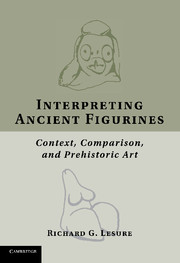Book contents
- Frontmatter
- Contents
- Figures and Tables
- Acknowledgments
- Introduction
- One Universalist Explanation and Prehistoric Figurines
- Two Comparison and Context
- Three The Questions We Ask of Images
- Four A Cross-Cultural Explanation for Female Figurines?
- Five Mesoamerican Figurines and the Contextualist Appeal to Universal Truths
- Six Figurines, Goddesses, and the Texture of Long-Term Structures in the Near East
- Seven On Figurines, Femaleness, and Comparison
- Notes
- Bibliography
- Index
Five - Mesoamerican Figurines and the Contextualist Appeal to Universal Truths
Published online by Cambridge University Press: 01 March 2011
- Frontmatter
- Contents
- Figures and Tables
- Acknowledgments
- Introduction
- One Universalist Explanation and Prehistoric Figurines
- Two Comparison and Context
- Three The Questions We Ask of Images
- Four A Cross-Cultural Explanation for Female Figurines?
- Five Mesoamerican Figurines and the Contextualist Appeal to Universal Truths
- Six Figurines, Goddesses, and the Texture of Long-Term Structures in the Near East
- Seven On Figurines, Femaleness, and Comparison
- Notes
- Bibliography
- Index
Summary
An important theme in the effort to grapple with comparison is the interpenetration of contextualism and universalism. In Chapter 2, I suggested that the interaction went both ways, and I have just concluded an effort to use contextualist strategies in addressing some of the chronic problems of universalist (social) explanations inspired by observations of (material) similarities between figurines. I turn now to the other side of the coin – to reliance on universalist claims as crucial links in context-specific arguments. The strategy is a common and probably necessary tool of interpretation, but it raises concerns. Specifically, such localized uses of universalist logic have unexamined expansive implications. The same logic might apply to what are usually numerous related cases of figurine making surrounding the context being studied. My goal here is to develop analytical strategies that allow us to address this characteristic concern.
My case study is the small, solid, fired-clay figurines of Formative Mesoamerica, and I conclude the chapter by considering what kinds of statements might usefully be made about “Formative figurines” as a general phenomenon.
The Problem
Of course, contextualist interpretation may draw on general concepts without using universalist logic. We might ask how “domestic space” was constituted in a particular community or how “female” and “male” were given meaningful content in a specific setting. The general concepts are tools for understanding specificity, but the generalities are subordinated to local specifics. They bring the specifics more clearly into focus.
- Type
- Chapter
- Information
- Interpreting Ancient FigurinesContext, Comparison, and Prehistoric Art, pp. 112 - 155Publisher: Cambridge University PressPrint publication year: 2011



